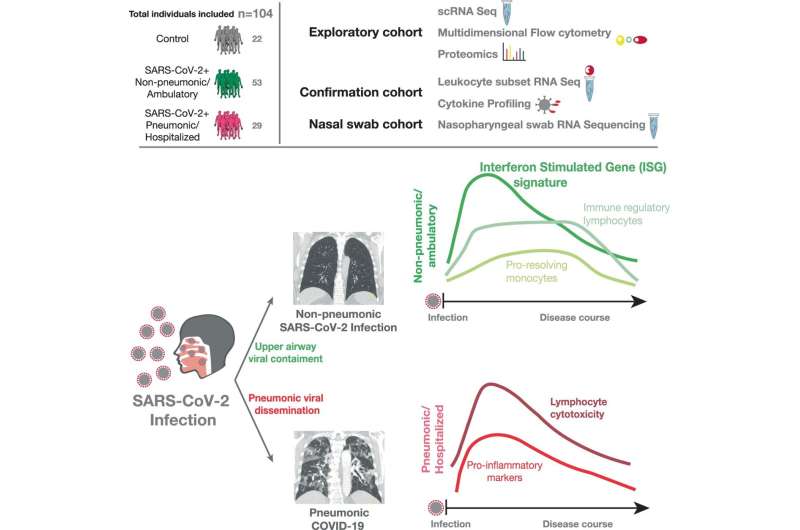How immune defenses are able to curb coronavirus and prevent pneumonia

Ludwig Maximilian University of Munich scientists have investigated how most people's immune defenses are able to curb the coronavirus so effectively that pneumonia does not occur.
The immune defenses of most people are able to curtail the spread of the SARS-CoV-2 virus in the body so effectively that they do not get pneumonia. But researchers have been largely at a loss to explain how exactly the invader is contained in the upper respiratory tract. Scientists at LMU's University of Munich Hospital led by Dr. med. Kami Pekayvaz, Alexander Leunig, Associate Professor Dr. med. Konstantin Stark, and Dr. med. Leo Nicolai, working in cooperation with other research institutions, have discovered that patients with mild disease courses had a specific, effective antiviral upregulation of so-called interferon-stimulated genes. The team's results have been published in the journal Nature Communications.
According to current research, 90 percent of infected persons are able to successfully ward off SARS-CoV-2 such as to prevent a severe course with infection of the lungs. To find out why this is the case, the team investigated blood samples and nasal swabs from over 100 patients—and did so using various methods for the analysis of genes, proteins, and other molecules that play a role in an immune response. They combined their findings with existing clinical data. Investigating patient samples over the entire course of the disease was the main focus of the study. First, the researchers closely monitored and analyzed a cohort of patients with risk factors for a severe course of the disease, distinguishing patients with and without pulmonary involvement. The findings obtained in this way were then validated in a large cohort of outpatients with mild courses of the disease.
"We discovered that early on in the disease, patients who had hardly any or no symptoms at all exhibited a very strong antiviral response in the immune cells in the blood," say the authors from the Medical Clinic and Polyclinic I located in the Munich district of Großhadern. The response is characterized by upregulation of interferon-stimulated genes (ISGs). "You can picture these as a whole arsenal of proteins that cells can use against viral intruders," explain the authors. "We think that this type of immune response prevents further spread of the virus, as the body is put on alert, meaning for example that the lung tissue is prepared for the intruder." Moreover, in mild cases so-called natural killer cells and T cells seem to be less aggressive towards other cells. This probably prevents the body's own cells becoming damaged. Finally, there was also an anti-inflammatory monocyte signature characteristic of a protective response.
In summary, the researchers say they have found a "specific immunological signature" that can prevent the SARS-CoV-2 virus from spreading in the body. Interestingly, this immune response is initially independent of antibodies, as they are produced later in the course of the illness.
"One goal now would be to modulate the immune system of high-risk patients or of individuals after viral exposition to activate these antiviral mechanisms," say the authors. And: "Approaches already exist towards this—for example, nasal sprays have been used that trigger such a response via interferon alfa or other mechanisms." These approaches should now be optimized, urge the authors, noting that such promising strategies could also prove helpful in the next pandemic against other viral pathogens than SARS-CoV-2.
More information: Kami Pekayvaz et al, Protective immune trajectories in early viral containment of non-pneumonic SARS-CoV-2 infection, Nature Communications (2022). DOI: 10.1038/s41467-022-28508-0


















